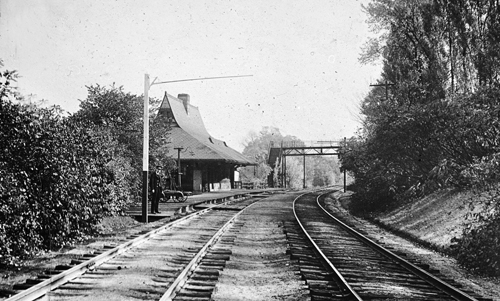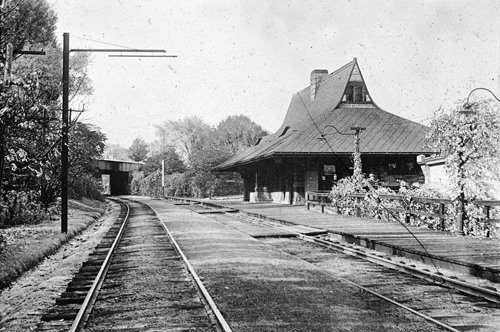 |
Three-car Train on Today's “C”
Seen here traveling east in Coolidge Corner, these cars were manufactured as part of a group of center-entrance cars, numbered from 6100 to 6299, that were introduced in1919/20. They were reduced in service by the late 1930s but briefly returned to service during periods of increased demand during World War Two.
|
 |
Beaconsfield Train Station
Looking east at the Beaconsfield station, built 1906. On the left is the building housing the garage and stables of Beaconsfield Terraces. The lower half remains today as the base of an apartment building.
[Source: Joel Shield]
|
 |
Beaconsfield Train Station
Looking east at the Beaconsfield station, built 1906. On the left is the building housing the garage and stables of Beaconsfield Terraces, its lower half remains today as the base of an apartment building. The building in the background is no longer standing.
|
 |
Boston Elevated Railway Bus, Circa 1927
The Boston Elevated Railway opened a “de luxe” bus line between Brookline and Boston in 1927. It initially started in Coolidge Corner, that was later extended to Washington Square. The license plate of this bus, stopped in Cleveland Circle, is dated 1927 but it is not clear which route is involved. Beacon St. inbound is off screen to the right. Boston’s Sutherland Rd. descends in the middle of the photo.
[Source: Joel Shield]
|
 |
Reservoir Station, Boston and Albany Railroad
[Source: Iowa State]
|
 |
Reservoir Station, Boston and Albany Railroad
[Source: Iowa State]
|
 |
Reservoir Station, Boston and Albany Railroad
[Source: Iowa State]
|
 |
Early Beacon St. Trolley Car
Shown in front of the Oak Square, Brighton car barn. This car was the first to run on Henry Whitney's groundbreaking streetcar line which started service in 1889. It was used on two routes: Beacon Street from Coolidge Corner to the Chestnut Hill Reservoir and from the Allston powerhouse to the car barn in Oak Square.
|
 |
Early Electric Trolley Car
This car was the first model to run on Henry Whitney's groundbreaking streetcar line which started service in 1889 as part of the widening of Beacon Street.
|
 |
Brookline Hills Station, 1907
|
 |
Cypress St. Train Station
Standing on Cypress St. looking west at the station. Tappan St. goes west right behind the station. This precedes the 1891 construction of the bridge over the tracks that still stands today.
|
 |
Walnut St. and Morss Ave.
Occupied at the time of this photo by the Brookline Riding Academy at #2 and #4 Walnut St, this building was first erected in 1875 by the Metropolitan Railway Co. to house the horse-drawn cars servicing the Brookline-Roxbury Crossing-Tremont House line. It was closed as a car house in December, 1894, with the move to new electrified routes, and demolished in 1918.
[Source: Leo Sullivan]
|
 |
Brookline Village Car House of the West End Railway Co.
#2 Walnut St, the car house of the West End Street Railway Co. The building was first erected in 1875 by the Metropolitan Railway Co. to house the horse-drawn cars servicing the Brookline-Roxbury Crossing-Tremont House line. It was closed as a car house in December, 1894, with the move to new electrified routes, and demolished in 1937.
[Source: Leo Sullivan]
|
 |
Lower Washington St., mid 1930s
Looking west on lower Washington St. toward the start of Boylston St. In the center of the photo, situated across High St. from the fire station, the Ford sign of T. C. Baker, a Ford dealership at 2 Boylston St., is visible. This is one of three photos taken of this block.
[Source: Historic New England]
|
 |
Village Transfer Station, circa 1911
On Lower Washington St., recently completed in September, 1909. On the left is Boylston St. looking west. The grocery store of Thomas F. McMahon is visible behind the left platform. The Sagamore Café, which closed in April 1912, and the drug store of T. E. Burns are visible behind the second station.
[Source: MBTA]
|
 |
First PCC Streetcar, Brookline Village, circa June 1937
Looking west on Lower Washington St. Shown is PCC streetcar 3001, the very first of a line of new “PCC” streetcars purchased by the Boston Elevated Railway Co. This car was the only car purchased from the St. Louis Car Co., all subsequent cars being purchased from the Pullman Co. In the rear, the ivy-covered fire station is visible. The waiting platforms in the photo were demolished in September 1938.
It is evident from the “No Stops” destination panel, and the fact that this car never ran on routes going through Brookline, that this is one of the demonstration/training runs conducted following the delivery of the car in May 1937. The car was given the nickname of “Queen Mary” and began regular service on June 24, 1937, running on routes that did not go underground as it only had doors opening on the right side. This car has been widely reported on by the enthusiast community and there is even a scale model available for purchase.
|
 |
Brookline Village, 1937
Looking east on lower Washington St. toward Boston. Parker Hill and N.E. Baptist Hospital upper right. Walnut St. on the right. Taken on 11/29/1937 by C. Parker, Brookline Engineering Dept.
|
 |
Brookline Village, 1937
Looking east on lower Washington St. toward Boston. Walnut St. on the right. Note scaffolding for the construction of the Brookline Theater on the left side of the street. All the buildings were raised in the 1960s as part of a large urban redevelopment program. Photo taken on 11/29/1937 by C. Parker, Brookline Engineering Dept.
|
 |
Brookline Ave & Washington St (Rt. 9), 1923
Looking east on Washington St. (Rt. 9) toward the Boston line, Brookline Ave. to the left. Huntington Line of the Boston Elevated Railway.
[Source: Joel Shield]
|
 |
Brookline Village. Horsecar at Morss Ave & Walnut St. Stable, 1893
This is the last remaining horsecar in Brookline. Service began in 1859 and will soon switch to electric. On the right is the corner of the car house at #2 Walnut St. The entrance to Morss Ave. is just to the left of that. #97 Washington St. is viewed left in the rear.
|